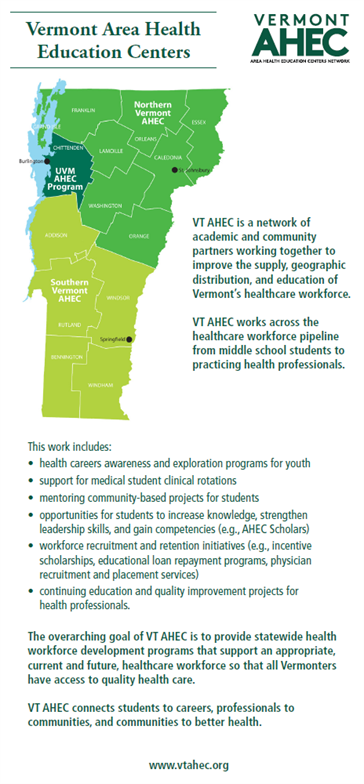Office of Primary Care (OPC) and Area Health Education Centers Program (AHEC)
Office of Primary Care
Encouraged by the Vermont Legislature, The Robert Larner, M.D. College of Medicine at The University of Vermont established the Office of Primary Care (OPC) in 1993 to focus the College of Medicine's commitment to primary care in Vermont. OPC is actively involved in teaching and research projects and in preparing the health workforce for the future.
In 1996, the OPC was awarded federal HRSA funding to establish a statewide AHEC program to focus on health workforce development.
Vermont Area Health Education Centers
VT AHEC is a network of academic and community partners working together to improve the supply, geographic distribution, and education of Vermont’s healthcare workforce. Established in 1996, VT AHEC has a statewide infrastructure with a program office at the University of Vermont Larner College of Medicine and two regional centers, each a 501c-3 non-profit organization. The overarching goal of VT AHEC is to provide statewide health workforce development programs that support an appropriate, current and future, healthcare workforce so that all Vermonters have access to quality health care, including those who live in VT’s most rural areas.
VT is made up of 14 mostly rural counties and has an estimated state population of 647,064. The Northern VT AHEC serves 8 counties (est. pop. 238,443), the Southern VT AHEC serves 5 counties (est. pop. 239,320), and the UVM AHEC Program serves 1 county (est. pop. 169,301). Vermont has 11 Federally Qualified Health Centers (FQHC) with 73 practice sites. One in every four Vermonters receives care at an FQHC.
VT AHEC works across the healthcare workforce pipeline from middle school students to practicing health professionals. AHEC has specific goals, milestones, and measures for each objective and activity. VT AHEC has a robust evaluation plan for the range of programs that we provide. These programs include health careers exploration for youth to interprofessional continuing education, educational loan repayment, scholarships, physician recruitment service, and the AHEC Scholars Program. VT AHEC’s Shared AHEC Network Database and Infrastructure (SANDI) system allows longitudinal tracking of program participants, which enables analysis of AHEC's short- and long-range outcomes and collective impact on the VT health workforce.
VT AHEC is funded through grants and gifts including federal HRSA, VT Department of Health, University of Vermont, and Vermont’s 14 hospitals.
Between July 2024 to June 2025, VT AHEC provided continuing education to 2,134 participants, generated more than 6,564 middle school, high school, and undergraduate student connections, and involved all medical students at the UVM LCOM, including 332 enrolled in the AHEC Scholars Program. VT AHEC continued to meet HRSA’s requirement to graduate a minimum of 30 AHEC Scholars annually. VT AHEC supported 71 primary care Family Medicine medical student clinical rotations. VT AHEC worked with 157 primary care practice sites in the state, many of which precepted UVM LCOM students. AHEC processed 376 applications to the VT Educational Loan Repayment Program for Healthcare Professionals and disbursed $1,672,860 in federal, state, employer, and private funds. Additionally, VT AHEC’s physician recruitment service directly facilitated 7 new physician placements in VT, with 3 in rural areas and 1 working at the FQHC in Chittenden County. The remaining 3 physicians, while not in rural areas, work at organizations/in positions that serve significant numbers of underserved patients.
VT AHEC is an essential health workforce development infrastructure in the state working to “Connect students to careers, professionals to communities, and communities to better health.”
AHEC in Vermont
